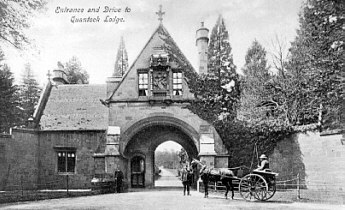Quantock School History
Introduction and Background
What was to become the Quantock School was founded in 1962 by David T. Peaster, nine years after it had originated as Cotham High School for Boys in Bristol. The school was based at the Quantock Lodge, a fine mid-nineteenth century late-Gothic mansion located in the forest at the foot of the Quantock Hills in the quiet hamlet of Aley near the villages of Over Stowey and Nether Stowey in the County of Somerset, and a short distance from the towns of Bridgwater and Taunton. The forest is the haunt of red deer and wild ponies and is the largest block of forest in Somerset, and in the village of Nether Stowey one can also find the onetime cottage home of the poet Samuel Taylor Coleridge.
Lord Taunton and Quantock Lodge
The original main school building, known to all who attended the school as the "Old Building", had been developed between 1857 and 1859 on the instruction of Henry Labouchere (1798-1869), the then Lord (previously Baron) Taunton. Before he was awarded the title of Lord Taunton, Henry Labouchere had played a significant role in government; he had been the Whig Member of Parliament for the town of Taunton from 1830 until 1859 - a stretch of nearly thirty years - and between 1847 and 1852 had held a post in the cabinet as the President of the Board of Trade.
Even a cursory study reveals that Henry Labouchere was a very wealthy man, with perhaps an even bigger wealth of connections in the banking trade. He married his first wife Frances Baring as a means of achieving a business deal, namely a merger between the Hopes bank, for whom Henry Labouchere was a board member, and of course Barings Bank. Two years after Frances' death in 1850, Labouchere married Mary Matilda Georgiana Howard, who was from an influential family that could trace its line back to Catherine Howard, one of Henry VIII's six wives and a descendant of Charles Howard, the first Earl of Carlisle. In all Henry Labouchere had three children, all daughters - one from his first wife (Emily Harriet) and the other two from his second (Mary Dorothy and Mina Frances).
Labouchere commissioned the redevelopment of the Quantock Lodge with the intention of using it both as a summer residence and home for his and his second wife Mary's sizeable art collection, enlisting the architect Henry Clutton to develop the then existing building into a mansion with a distinctive 'free Tudor' style, who was particularly well-known in the region. In addition to the Lodge Labouchere had purchased other land in the Over and Nether Stowey area, which was to be known as the Quantock Estate. Throughout the late 1850s and early 1860s further properties were built on the estate, including the original stable block.

Above: A postcard image of the entrance archway to Quantock Lodge, taken soon after its construction in the mid nineteenth century.
Lord Taunton died in 1869 at the age of 71; there are two portraits that include Lord Taunton held in the National Portrait Gallery in London; the first, by Sir George Hayter, is one of the House of Commons, while the second, by William Menzies Tweedie, is a portrait of Lord Taunton himself. The first work is on open display at the gallery.
The death of Lord Taunton and the sale of the Quantock Estate
Following Lord Taunton's death, his estate passed into the hands of his widow and subsequently the noble Stanley family following the marriage of Henry's eldest daughter Mary Dorothy ('Mimi') to the Army officer Edward James Stanley. Lord Taunton himself had left no direct male heir; the family line continued with his brother John Peter, and after that his rather rebellious nephew Henry Du Pré Labouchere (1831-1912), who followed his uncle into politics via Eton, Cambridge, a failed diplomatic career and a stint as a journalist and writer.
Following Mimi Stanley's death in 1920 her son Edward Arthur Vesey ('E.V.') Stanley sold the entire estate; the smaller properties were used by the county council to provide small holdings, while the principle residence, along with some 2,045 acres of land, was purchased by the council under the Public Health Act. Most of the treasures the house had contained had already been sold, and most of the remainder were auctioned off at Sotheby's.
Five years after the sale the building was reopened as the Quantock Lodge Sanatorium, which was used for treating those suffering from tuberculosis - as opposed to a sanitarium used to house mental patients, a legend that soon became popular among later generations of Quantock School pupils. Following the closure of the hospital in 1962, the property and surrounding land was purchased by David T. Peaster, paving the way for the formation of the Quantock School that same year and its opening to pupils in 1964.
next »